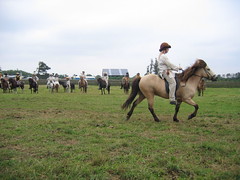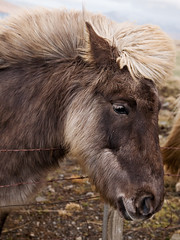Cavallo Article on the Icelandic Horse World Championship
Cavallo, a German magazine, recently published a scathing review of the Icelandic Horse World Championships 2007, held in Oirschot, Holland. Pictures accompanied the article, and as they say, a picture, or several pages of them speaks a thousand words.
The article gathered the thoughts and opinions of several well-respected equestrians, including Dr. Ulrike Theil, head of Hippocampus, Institute for Equitherapy and Equine Sport Psychology in the Netherlands. Other professional trainers involved with the Icelandic breed itself were also quoted, including German gaited horse trainer and judge Andrea Jaenisch, German breeder and judge Thommy Haag, Austrian Icelandic horse trainer Gereon Wimmer, Breeder Bruno Podlech of the Wiesenhof stud in Germany, and Birgit Dresel of Windwalker Farm in Germany. Of all of these, only Bruno Podlech offered support of what was witnessed in the show ring at Oirschot.
Basically, the Cavallo article exposed the trend for the Icelandic show ring to reward forced gait brought on by domination instead of good equitation and training. It also pointed out the lack of regard for the horses' physical and psychological well-being in how they were being ridden. What words didn't express, the telling pictures accompaning the article did.
Bruno Podlech explained that expressions of stress and panic in the pace racers as "normal" and that the horse should be close to bolting for good pace. This sentiment was in complete opposition, however, to what the other experts quoted had to say: Fear as a block to communication between horse and rider was cited as well as the what happens to a horse's body physically when asked to perform under such body tension and stress.
Though many say the gait of the Icelandic is unique and therefore, requires special riding, Cavallo brings readers back to reality in reminding that ALL horses are subject to the same rules of biomechanics and that poor riding is simply that -- poor riding. Restraints on these little horses, such as severely tightened nosebands, mis-use of severe bits, heavy rein contact and pulling, and saddles slid back with riders sitting on loins was also pointed out as problems that need to be recognized and remedied within the breed. But first, people have to SEE these things as wrong and the poor techniques of riding they are.
The article brought up several points as to why there is no equitation in the Icelandic horse show ring: Lack of education both in training of the horses and the riders, isolation from the rest of the equestrian world, no appreciation for good, natural, correct gait (that isn't showy or possessing of great animation and lift), and a classic case of what wins is what gets emulated -- even if it's bad.
Compounding the problem is the fact, as in the dressage world, good riders are often driven away from the Icelandic show ring when they see the abuses getting rewarded. Although the international organization governing Icelandic competitions, FEIF, does issue warnings and give "yellow cards", Cavallo points out it takes extremely rough riding to garner one of these cards or warnings -- and even then, the penalties are negligible. One of the commenters in the article even went so far as to say that if poor riding was punished more severely, only five percent of the current riders would remain.
As a bright spot, there was mention of "brave ambassadors" for the breed who, like those quoted in the article, have decided to take an often unpopular stand against the show ring abuses seen at the World Championships. Internet chat groups are a good venue to point out what is happening, and what is wrong. Unfortunately, such pictures as published in the Cavallo article have become "normal" to many people in the breed, so it's likely going to be a long struggle to get people to understand.
The article finishes with individual comments on each of the pictures from the experts, who do not mince words.
Sadly, none of the pictures exemplfy Dr. Theil's personal motto, and which should perhaps, be the motto of every aspiring horseman: "Harmony between man and horse by the development of knowledge, technique, and feeling."
Teaching a Horse to Talk
-
Listen very carefully to hear the horses "talking". As they learn, they
will get louder; this is just the start.
14 years ago





















